
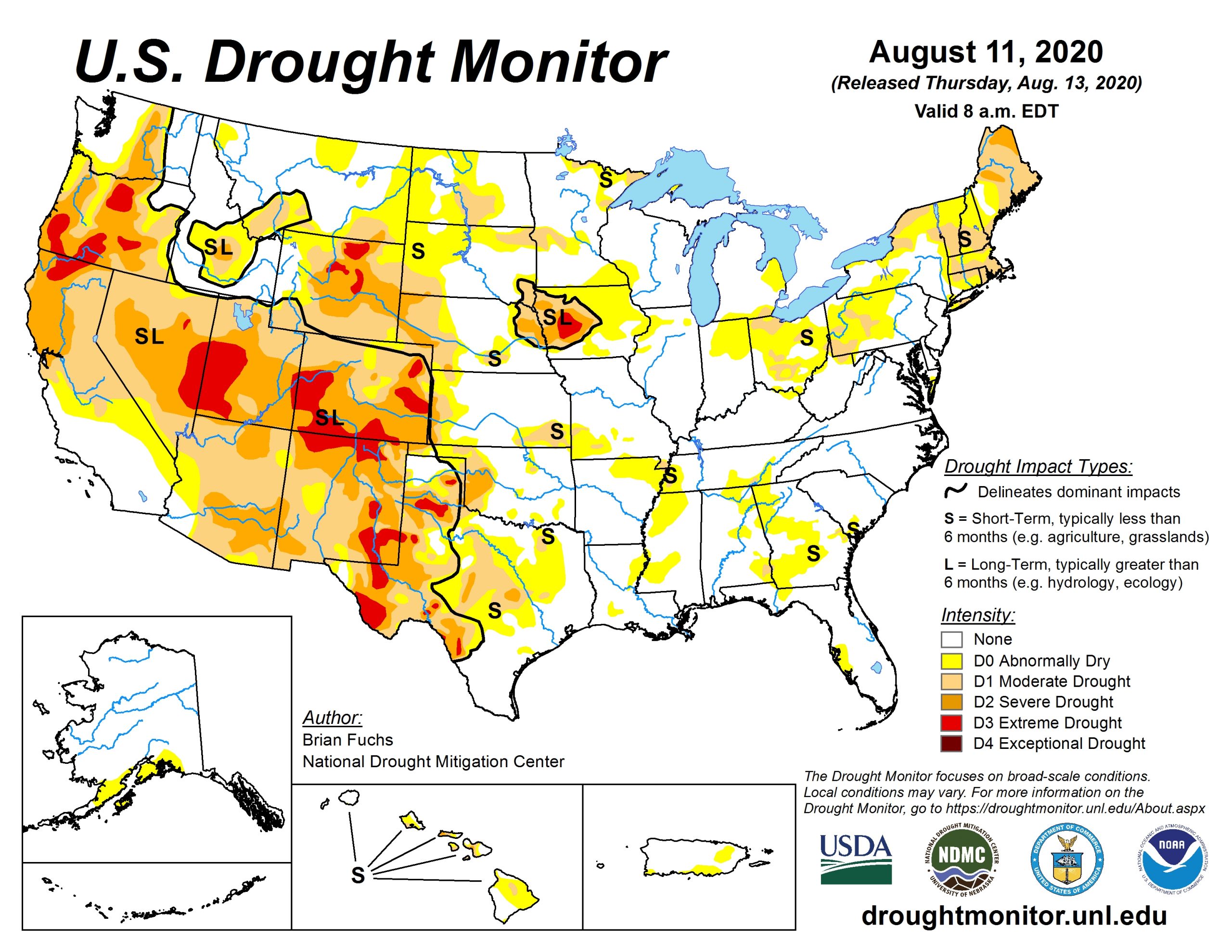
Wildfire activity has been accelerating in the western US in the month of August, as fuels continue to dry out. Drought expansion has been rapid and intense in the Great Basin and Rockies, where several large fires in Colorado are threatening property and infrastructure. The Great Basin, northern California, Pacific Northwest, and northern Rockies are expected to experience Above Normal significant wildland fire potential in the month of August. As precipitation and cooler temperatures arrive in fall, areas of concern will shift southward to portions of California as seasonal wind events become more likely.
Current Fire Activity
- There are currently 12 large fire incidents that are being actively managed across the US, including the new Lake Hughes Fire which is spreading rapidly on the outskirts of Los Angeles.
- Extremely warm temperatures and locally gust winds caused the brush fire, which ignited on August 12th, to spread rapidly to over 12,000 acres and force the evacuation of over 500 homes.
- The Guy Carpenter Wildfire Risk Score illustrates vast areas of Extreme (pink) wildfire risk in the Angeles National Forest where the fire is burning uncontrolled.
[caption id="attachment_51876" align="aligncenter" width="750"]

The Lake Hughes Fire Perimeter on August 13, overlaid on the Guy Carpenter Wildfire Risk Score, illustrating extreme fire risk in the area (pink) due to terrain and fuels[/caption]
- The Grizzly Creek Fire in Colorado has closed portions of Interstate 70 near Glenwood Springs for several days and is threatening community and structures.
[caption id="attachment_51881" align="aligncenter" width="750"]
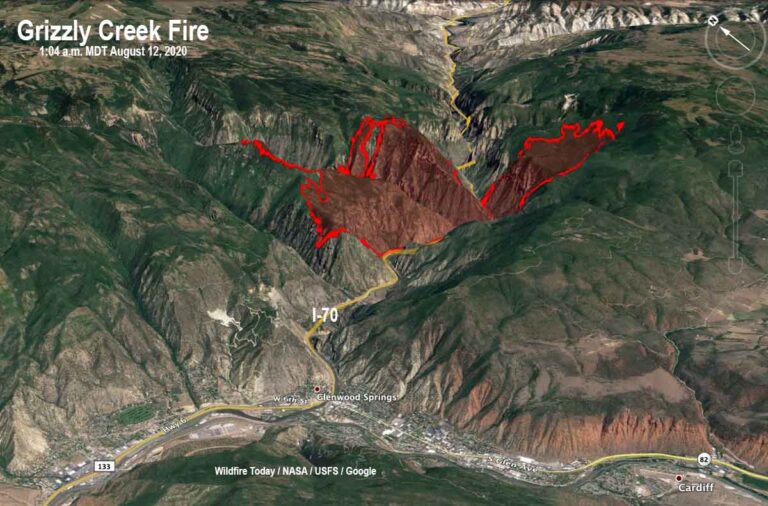
Grizzly Creek Fire Perimeter as of August 12th (Wildfire Today)[/caption]
- The Guy Carpenter Wildfire Risk Score illustrates high to very high wildfire risk (orange to red) on the western flank of the fire leading toward the community of Glenwood Springs, only two miles way, although light winds have kept spread in this direction to a minimum so far.
[caption id="attachment_51882" align="aligncenter" width="750"]

Grizzly Creek Fire Perimeter as of August 13, overland with Guy Carpenter Wildfire Risk Score showing high to very high risk in the area due to terrain and fuels[/caption]
- To date, there have been approximately 35,000 fires in the US, which is slightly below the 10 year average of 38,000 fires by mid-August.
- Interestingly, while the number of fires is fairly consistent with the decade long average, the number of acres burned in 2020 so far is well below average, and much lower than the high fire activity seasons of 2017 and 2018.
- This suggests that while fire season is active in 2020, fires have been relatively small and well contained to date.
[caption id="attachment_51892" align="aligncenter" width="750"]
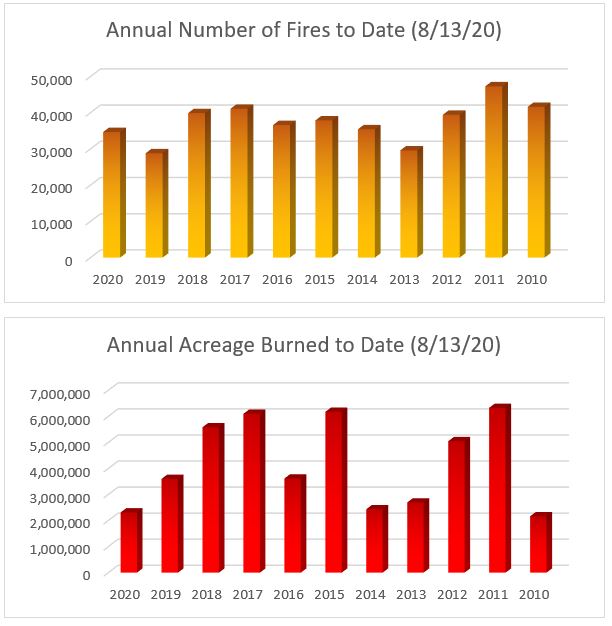
Annual Number of Fires (Top) and Acreage Burned (Bottom) as of August 13 (National Interagency Fire Center)[/caption]
Drought Conditions and Forecast
- While the onset of the monsoon relieved drought conditions in the Central Plains and Four Corners regions, rapid drought intensification occurred in the Great Basin and northern Rockies.
- In localized areas, there has been a two to three class drought degradation.
[caption id="attachment_51879" align="aligncenter" width="750"]
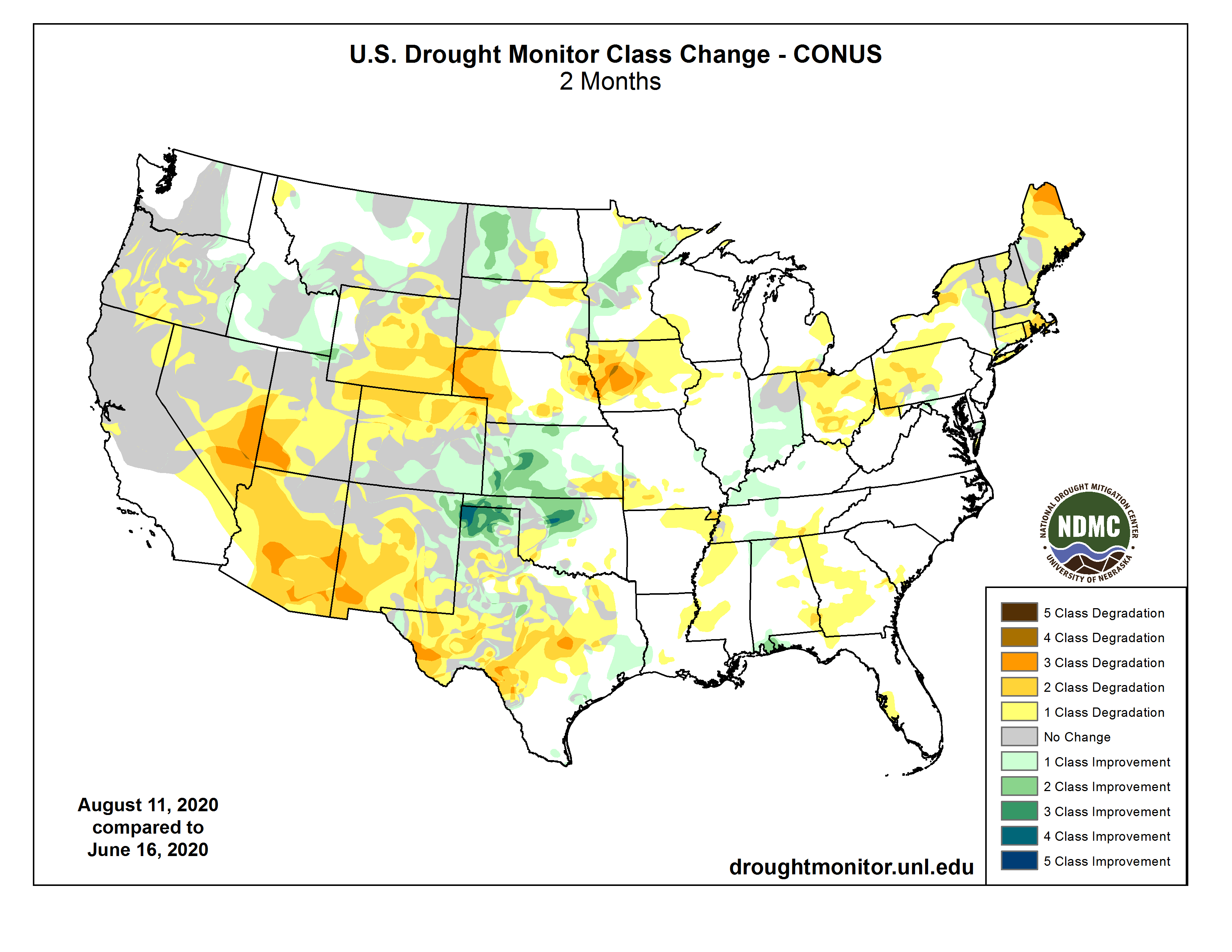
Two month drought tendency from US Drought Monitor for mid August, 2020[/caption]
- A dry climatology in August favors the persistence of drought conditions through the intermountain west in the coming month, with an expansion possibly due to expected precipitation deficits and warm temperatures.
- Southern California remains drought free due to continued below average temperatures and the benefit of early summer precipitation.
[caption id="attachment_51884" align="aligncenter" width="750"]
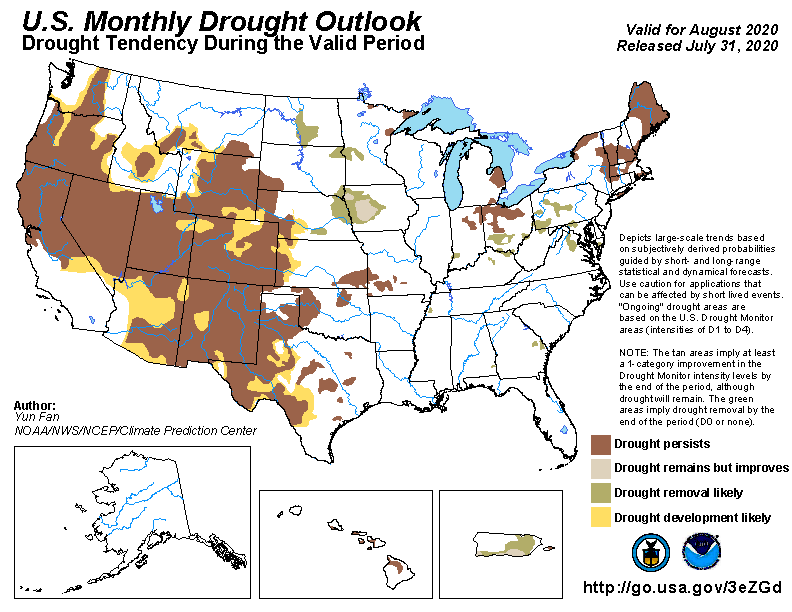
US Seasonal Drought Outlook valid for August 2020 (NOAA/CPC)[/caption]
Climatological Outlook
- Above average temperatures are expected in the short term for all areas west of the Continental Divide, with a warm fall expected across the entire United States.
- Heat will be coupled with a precipitation deficit for much of the intermountain West, while California transitions into a normal dry state into the fall.
- The expected warmth and lack of precipitation will result in fuels continuing to dry out through the remainder of wildfire season in the West.
- Fuel curing will also continue in California, where the onset of offshore winds in the fall months will create fire danger.
[caption id="attachment_51886" align="aligncenter" width="750"]
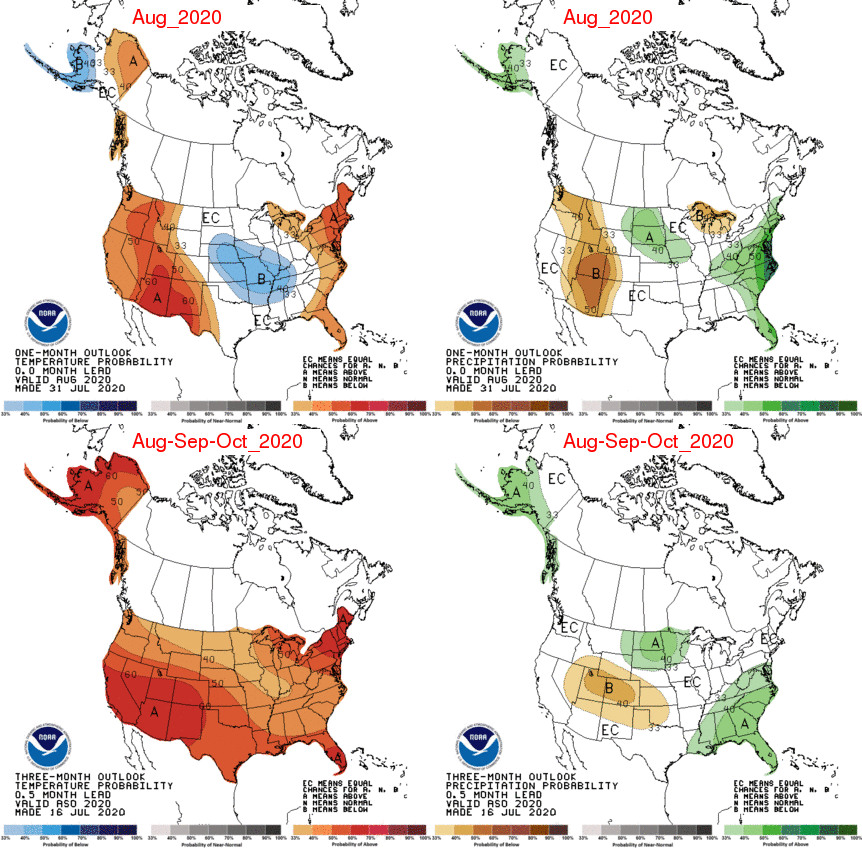
One month (top) and three month (bottom) outlooks for temperature (left) and precipitation (right) (NOAA Climate Centers)[/caption]
Significant Wildfire Outlooks
- Heat and drought will keep the Great Basin, Northern Rockies and Northern California in a state of Above Normal Significant Wildland Fire Potential through the heart of Western US Wildfire Season.
- Persistent fall warmth will keep the risk elevated in this regions through September.
- The onset of winter and associated cooler temperatures and precipitation will relieve some fire conditions and the expectation is much of the western US will return to a state of Normal Signficant Wildland Fire Potential by October.
- The exception will the coastal mountain regions of California, which will be in a state of Above Normal Significant Wildland Fire Potential into the fall due to the onset of seasonal offshore winds like the Santa Ana Winds.
- Another exception will be a good portion of the Southeast US, where the expectation of cooler than normal waters in the tropical Pacific (La Nina) will lead to warmth and dryness across the region in the fall; this is of course tempered by the possibility of tropical systems in the Atlantic bringing moisture to the region during the peak of Hurricane Season.
[caption id="attachment_51888" align="aligncenter" width="750"]
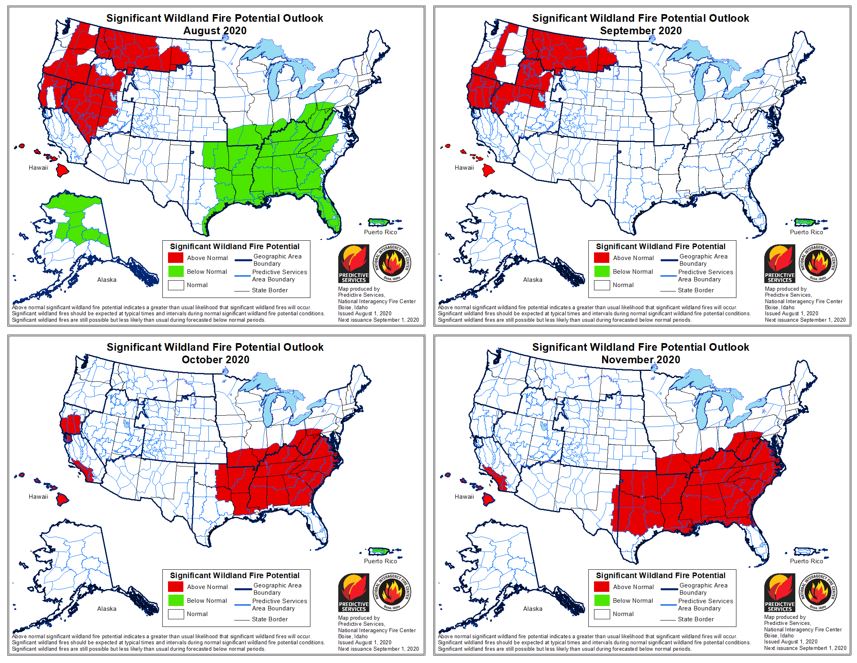
Significant Wildland Fire Potential Outlook for August (top left), September (top right), October (bottom left) and November (bottom right) (Predictive Services and National Interagency Fire Center)[/caption]
Canada
- Wildland fire activity in Canada is also much below average as measured by number of fires (61% of normal) and acreage burned (9% of normal).
- Period Pacific storms are providing rainfall and below average temperatures for much of the Canadian Rockies region, keeping activity down.
- Significant fire bans remain in place in British Columbia and Alberta, where southern portions of these provinces are in high to extreme fire danger rating according to the Canadian Wildland Fire Information System.
[caption id="attachment_51893" align="aligncenter" width="750"]
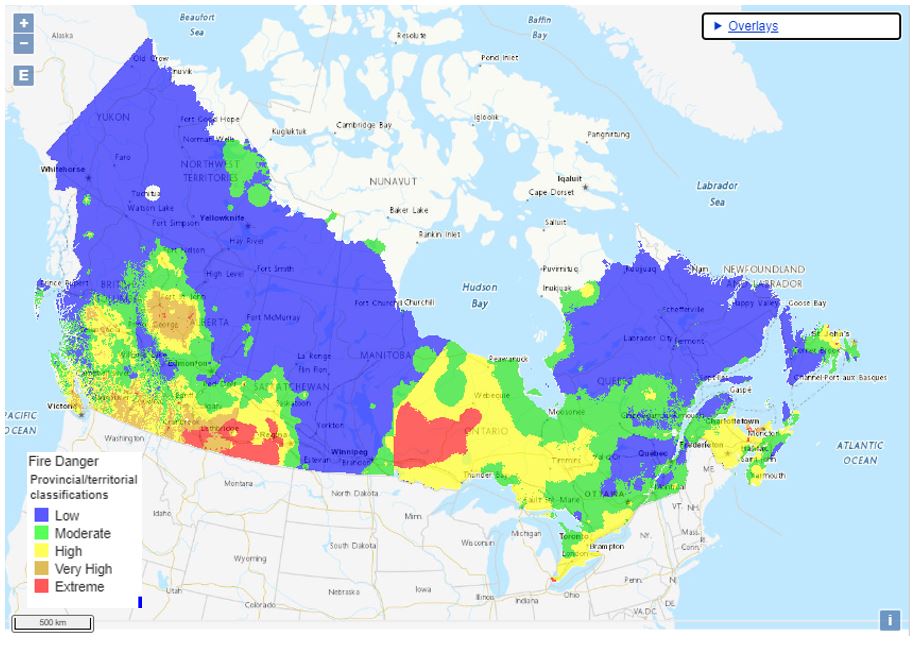
Fire Danger Rating for August 13, from the Canadian Wildland Fire Information System[/caption]
- Most of Canada remains in an Average Forecast Severity Anomaly for August and September.
[caption id="attachment_51894" align="aligncenter" width="750"]
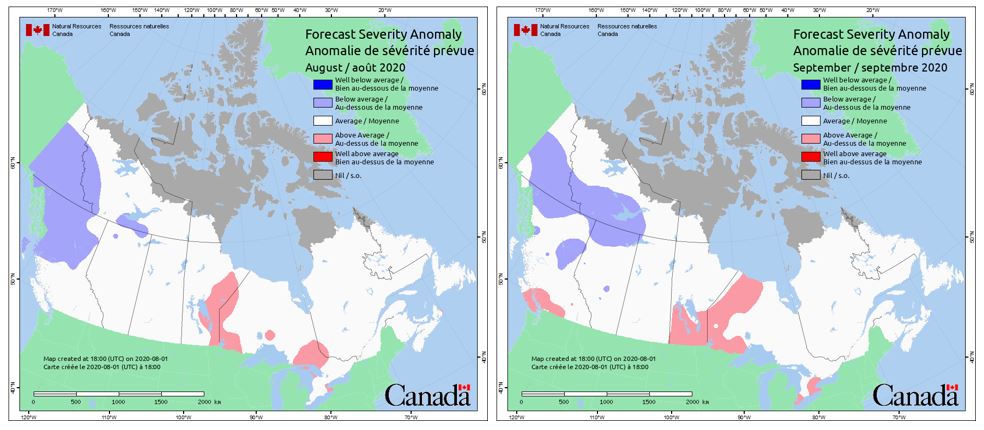
Wildfire Forecast Severity Anomaly, August (left) and September (right) 2020 (CWFIS)[/caption]
Weather Sentinel updates will be issued for North America during the 2020 wildfire season if an event is threatening a region of insured exposure. Monthly outlooks of significant wildfire potential will also be issued monthly to monitor areas of increased risk during the 2020 season. To receive email notifications of Weather Sentinel updates, please visit the GC Preference Center.